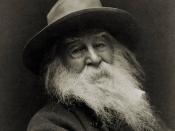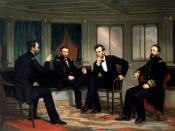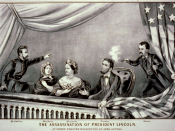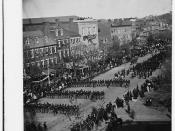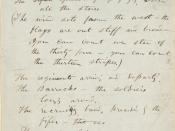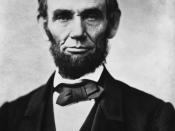"When Lilacs Last in the Dooryard Bloom'd"� "When Lilacs Last in the Dooryard Bloom'd"� is one of Walt Whitman's best known and most popular poems about Abraham Lincoln. In "Lilacs"�, Whitman portrayed himself as a representative of the American public's chief mourner of Lincoln's assassination. Within this poem he could embody and abate the sorrow felt by millions of citizens in the North and South(Marinacci 240).
"Lilacs"� is a free-flowing poem in which three images interweave with meditations on death and the war. The poem operates on several different levels that continually overlap.
Whitman's attempt to reconcile himself to Lincoln's death becomes a reconciliation to death on a personal, national, and global level. Lincoln's death becomes an occasion for the poet to try and heal wounds and to grieve publicly while trying to make poetic and historic sense out of the seeming waste of the Civil War (Erkkila 234).
Even though Lincoln was shot on Good Friday, Whitman does not attempt to compare the obvious symbolism of Christ and Lincoln. He does give the poem religious suggestions by linking Lincoln's death with spring and the trinities formed of the senses and sounds, lines and images woven throughout the poem(Erkkila 229).
Whitman refuses to use Lincoln's name in the poem or any other poem he writes about Lincoln. He relied on the fact that the nation was familiar with the events surrounding his death and recognized the subject of his work. He used instead, the imagery of the western star to represent Lincoln. The western star (which was actually the planet Venus) in its largest configuration is a star of the American Union. The star was also observed during Lincoln's second inauguration and Whitman's poem tells us that he now realized that the star had been trying to warn him a month earlier at the inauguration. When Whitman heard of Lincoln's death the lilac buds were just beginning to bloom.
These were a cherished flower of Whitman's childhood, which became a lasting sensory connection to Lincoln's assassination.
The thrush represents all of nature singing its sorrow. Whitman tells the thrush that he cannot listen to him yet because he was still detained by the "lustrous star"� and that he had his own song of grief to sing. The journey in the poem alludes to the funeral procession that carried Lincoln's coffin from Washington D.C. to its final destination of Springfield, Ill. The coffin that journeyed through the woods through violets spotted gray debris was suggesting the blue of the Union and the gray of the Confederate soldiers. In later passages of the poem the coffin's path taken during the journey represents the paths taken by all the war dead that had journeyed throughout the states to depots full of mourning faces(Erkkila 231). Near the poem's end, Whitman is still held by grief but advanced toward a "sacred"� knowledge by observing the continuation of a prosperous world.
He tells us that from his observation of an ongoing world, death is a part of a regenerative cycle and that we should move toward accepting everyone's death, particularly Lincoln's. The conclusion of the poem is a consolation offered to the nation as the poet's song, which is an act of life and creation that will memorialize Lincoln's death and the total sacrifice of the war(Erkkila 237).
